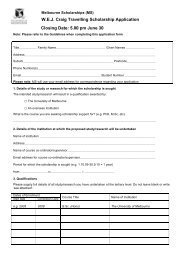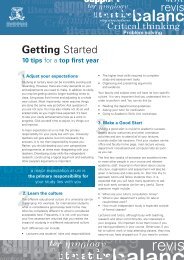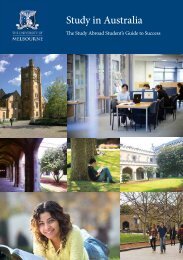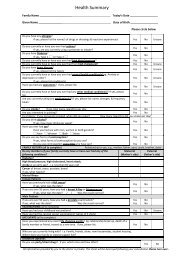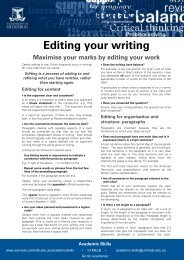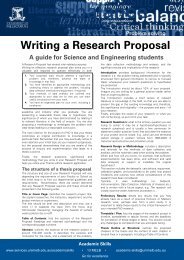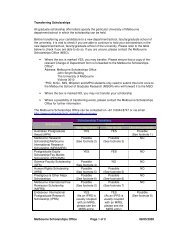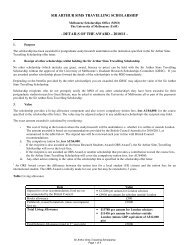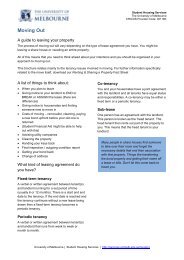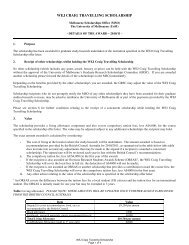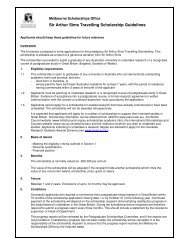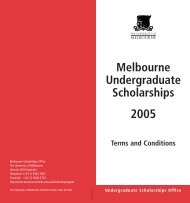a growing experience - Student Services - University of Melbourne
a growing experience - Student Services - University of Melbourne
a growing experience - Student Services - University of Melbourne
Create successful ePaper yourself
Turn your PDF publications into a flip-book with our unique Google optimized e-Paper software.
HEALTH AND WELL-BEING OF INTERNATIONAL STUDENTSbelong to organisations at the university and <strong>of</strong>f campus, including religious groups,significantly more than females.Female students do show greater levels <strong>of</strong> psychological distress than male students.They have significantly higher scores on the Abuse and Distress scale and the Stressscale. They have lower levels <strong>of</strong> self-esteem, have <strong>experience</strong>d greater distress aboutrelationships during their studies here and are involved in a significantly higher level<strong>of</strong> self-harm. In contrast, males are significantly more involved in gambling andsmoking, possibly an alternative form <strong>of</strong> maladaptive response. Consistent with thesedifferences, there are significantly more females than expected among studentsexhibiting an unconnected and stressed style <strong>of</strong> adaptation and significantly moremale students than expected among those with a distressed and risk-taking approach.While the gender differences mentioned are all statistically significant, the effect sizesare almost all small, about .2. The exception is the gender difference on the Abuseand Distress scale, where there is a medium effect size <strong>of</strong> .55, indicating an area thatis important to consider. Female students feel generally less safe than male students.They <strong>experience</strong> a higher rate <strong>of</strong> physical abuse and sexual harassment, but a lowerrate <strong>of</strong> verbal abuse than male students. They also report a higher level <strong>of</strong> distressthan males in response to abuse. These findings are consistent with other recentAustralian findings <strong>of</strong> a lesser feeling <strong>of</strong> safety and a greater <strong>experience</strong> <strong>of</strong> badtreatment among female compared with male international students in Australia(Deumart et al., 2004; Deumert, Marginson, Nyland, Ramia, & Sawir, in press).RELATIONSHIPSTwo demographic variables concerning relationships were examined for theirassociation with students’ sense <strong>of</strong> well-being in different domains <strong>of</strong> life in Australia:marital status and, for those with children, having a child present with them inAustralia.Although four categories <strong>of</strong> marital status were provided for response, only twostudents indicated that they were divorced or separated and only one was widowed.As a result, analyses focused on two categories only: being single or beingmarried/partnered. Group differences on the basis <strong>of</strong> marital status are mainlyconcerned with social activity, <strong>experience</strong> <strong>of</strong> cultural stress, other forms <strong>of</strong>psychological distress and sexual behaviour.Single students mix significantly more than married/partnered students with coculturalson and <strong>of</strong>f campus, and significantly less with Australians in both locations.They also belong to more organisations at the university and outside, includingreligious groups, than their married/partnered counterparts. It is interesting that thetwo groups do not differ significantly in terms <strong>of</strong> their connectedness in <strong>Melbourne</strong>.One might expect that being married or partnered would increase a sense <strong>of</strong>connectedness, although only if the partner were also living in <strong>Melbourne</strong>.Single students <strong>experience</strong> higher levels <strong>of</strong> cultural stress and stress from familyexpectations than married/partnered students. Single students also <strong>experience</strong> greaterdepression and anxiety, as well as a lower level <strong>of</strong> self-esteem. This finding, at leastin part, confounds marital status with age, because single students are much youngerthan married/partnered students (21.9 years compared with 28.2 years). YoungerRosenthal, Russell & Thomson, 2006 122



